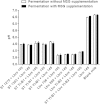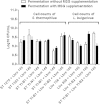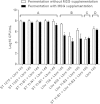Dairy Streptococcus thermophilus improves cell viability of Lactobacillus brevis NPS-QW-145 and its γ-aminobutyric acid biosynthesis ability in milk
- PMID: 26245488
- PMCID: PMC4526857
- DOI: 10.1038/srep12885
Dairy Streptococcus thermophilus improves cell viability of Lactobacillus brevis NPS-QW-145 and its γ-aminobutyric acid biosynthesis ability in milk
Abstract
Most high γ-aminobutyric acid (GABA) producers are Lactobacillus brevis of plant origin, which may be not able to ferment milk well due to its poor proteolytic nature as evidenced by the absence of genes encoding extracellular proteinases in its genome. In the present study, two glutamic acid decarboxylase (GAD) genes, gadA and gadB, were found in high GABA-producing L. brevis NPS-QW-145. Co-culturing of this organism with conventional dairy starters was carried out to manufacture GABA-rich fermented milk. It was observed that all the selected strains of Streptococcus thermophilus, but not Lactobacillus delbrueckii subsp. bulgaricus, improved the viability of L. brevis NPS-QW-145 in milk. Only certain strains of S. thermophilus improved the gadA mRNA level in L. brevis NPS-QW-145, thus enhanced GABA biosynthesis by the latter. These results suggest that certain S. thermophilus strains are highly recommended to co-culture with high GABA producer for manufacturing GABA-rich fermented milk.
Figures






Similar articles
-
Comparative Peptidomic and Metatranscriptomic Analyses Reveal Improved Gamma-Amino Butyric Acid Production Machinery in Levilactobacillus brevis Strain NPS-QW 145 Cocultured with Streptococcus thermophilus Strain ASCC1275 during Milk Fermentation.Appl Environ Microbiol. 2020 Dec 17;87(1):e01985-20. doi: 10.1128/AEM.01985-20. Print 2020 Dec 17. Appl Environ Microbiol. 2020. PMID: 33067198 Free PMC article.
-
High γ-aminobutyric acid production from lactic acid bacteria: Emphasis on Lactobacillus brevis as a functional dairy starter.Crit Rev Food Sci Nutr. 2017 Nov 22;57(17):3661-3672. doi: 10.1080/10408398.2016.1147418. Crit Rev Food Sci Nutr. 2017. PMID: 26980301 Review.
-
Effect of adzuki bean sprout fermented milk enriched in γ-aminobutyric acid on mild depression in a mouse model.J Dairy Sci. 2021 Jan;104(1):78-91. doi: 10.3168/jds.2020-19154. Epub 2020 Nov 6. J Dairy Sci. 2021. PMID: 33162095
-
Role of cysteine in the improvement of γ-aminobutyric acid production by nonproteolytic Levilactobacillus brevis in coculture with Streptococcus thermophilus.J Dairy Sci. 2022 May;105(5):3883-3895. doi: 10.3168/jds.2021-21486. Epub 2022 Feb 25. J Dairy Sci. 2022. PMID: 35221058
-
Microbial gamma-aminobutyric acid synthesis: a promising approach for functional food and pharmaceutical applications.Lett Appl Microbiol. 2024 Dec 2;77(12):ovae122. doi: 10.1093/lambio/ovae122. Lett Appl Microbiol. 2024. PMID: 39673306 Review.
Cited by
-
Comparative mRNA-Seq Analysis Reveals the Improved EPS Production Machinery in Streptococcus thermophilus ASCC 1275 During Optimized Milk Fermentation.Front Microbiol. 2018 Mar 13;9:445. doi: 10.3389/fmicb.2018.00445. eCollection 2018. Front Microbiol. 2018. PMID: 29593689 Free PMC article.
-
Screening and characterization of lactic acid bacteria and fermentation of gamma-aminobutyric acid-enriched bamboo shoots.Front Microbiol. 2024 Feb 5;15:1333538. doi: 10.3389/fmicb.2024.1333538. eCollection 2024. Front Microbiol. 2024. PMID: 38374919 Free PMC article.
-
Biodiversity and Classification of Phages Infecting Lactobacillus brevis.Front Microbiol. 2019 Oct 16;10:2396. doi: 10.3389/fmicb.2019.02396. eCollection 2019. Front Microbiol. 2019. PMID: 31681247 Free PMC article.
-
Optimizing Levilactobacillus brevis NPS-QW 145 Fermentation for Gamma-Aminobutyric Acid (GABA) Production in Soybean Sprout Yogurt-like Product.Foods. 2023 Feb 25;12(5):977. doi: 10.3390/foods12050977. Foods. 2023. PMID: 36900494 Free PMC article.
-
Comparative genome analysis of the Lactobacillus brevis species.BMC Genomics. 2019 May 23;20(1):416. doi: 10.1186/s12864-019-5783-1. BMC Genomics. 2019. PMID: 31122208 Free PMC article.
References
-
- Cherubini E., Gaiarsa J. L. & Benari Y. GABA - an excitatory transmitter in early postnatal life. Trends Neurosci 14, 515–519 (1991). - PubMed
-
- Dianaa M., Quílez J. & Rafecasa M. Gamma-aminobutyric acid as a bioactive compound in foods: a review. J Funct Foods 10, 407–420 (2014).
-
- Chuang C. Y., Shi Y. C., You H. P., Lo Y. H. & Pan T. M. Antidepressant effect of GABA-rich Monascus-fermented product on forced swimming rat model. J Agr Food Chem 59, 3027–3034 (2011). - PubMed
-
- Hayakawa K. et al. Effect of a gamma-aminobutyric acid-enriched dairy product on the blood pressure of spontaneously hypertensive and normotensive Wistar-Kyoto rats. Brit J Nutr. 92, 411–417 (2004). - PubMed
-
- Inoue K. et al. Blood-pressure-lowering effect of a novel fermented milk containing gamma-aminobutyric acid (GABA) in mild hypertensives. Eur J Clin Nutr. 57, 490–495 (2003). - PubMed
MeSH terms
Substances
LinkOut - more resources
Full Text Sources
Other Literature Sources
Molecular Biology Databases

